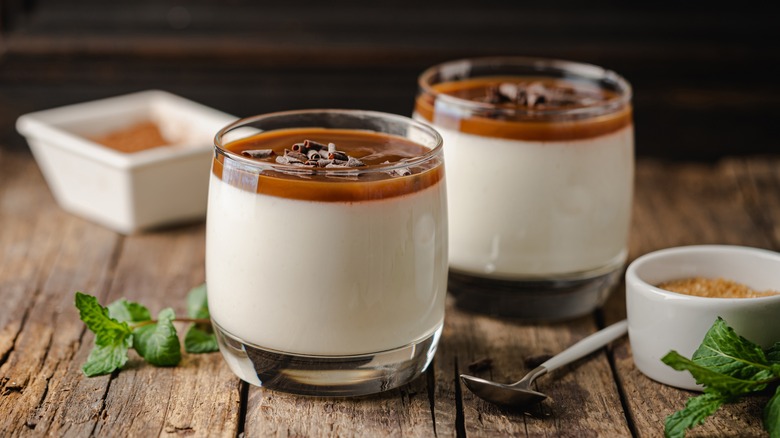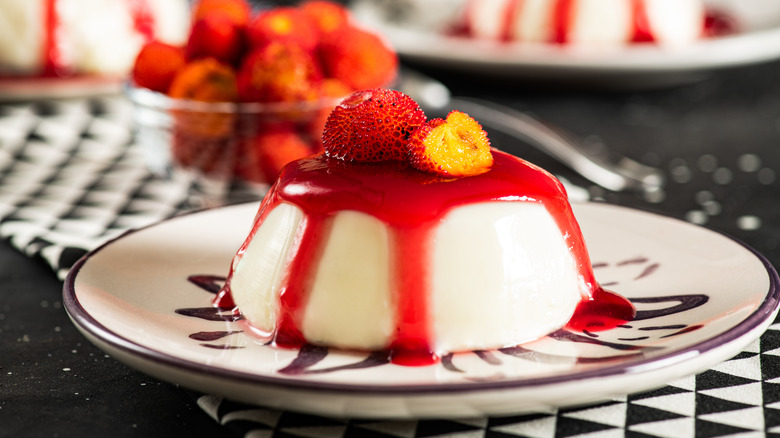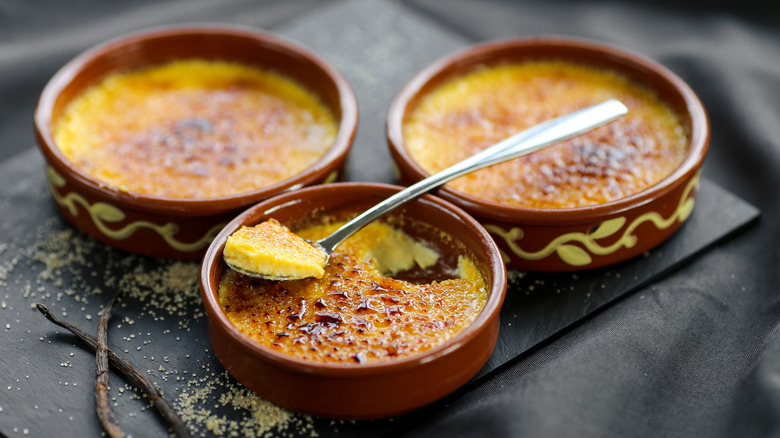Is There A Difference Between Panna Cotta And Crème Brûlée?
If you're a fan of sweet, simple, and comfortingly creamy desserts, then panna cotta and crème brûlée tick all the right boxes. Both made with sweetened cream — thickened until it becomes gloriously custardy and velvety smooth — the two sweet treats have much in common. But there are some very clear differences between the two indulgent classic desserts, too, from the ingredients used to the way they're prepared, and how they're served.
Panna cotta originates from the Piedmont region in Northern Italy, with the name of the dish translated into English as cooked cream. Although ironically, given its name, the dish is not actually cooked as such. Rather, the heated sweet cream is thickened with gelatin for a silky smooth texture and then refrigerated until it reaches a just-set consistency.
Although it has a French name, the origins of crème brûlée are much debated. But whatever its exact roots, the dessert, also known as burnt cream, is essentially a rich and gooey custard. It's thickened with eggs rather than gelatin, and topped with a layer of crisp caramel for a delightful combination of crunchy and soft textures.
Panna cotta is set with gelatin for a signature wobble
Panna cotta, at its most simple, is made by heating up cream and sugar, adding gelatin, and pouring into individual dishes to set. The Italian dessert is unashamedly creamy, and indeed was traditionally made just using cream – though most modern recipes call for a mixture of milk and cream, or even a little buttermilk, too, to make it less heavy.
As for how it is served, panna cotta can either be served in individual ramekins or unmolded onto a plate to show off its signature just-set wobble. The unmolding can be a potentially nerve-racking moment for home cooks who might not be confident that it won't just collapse into a creamy splodge on the plate, but it certainly looks impressive if you can pull it off. The hot water trick to get Jell-O out of any mold can also be applied to panna cotta to make things easier; just dip the mold in hot water before inverting it onto a plate.
The pale creamy dessert is often left unadulterated to show off its delicate creamy taste, but panna cotta can also be flavored with all sorts of different ingredients, from vanilla or fragrant rose to caramel, chocolate orange, or even boozy limoncello. The toppings are also customizable. Traditionally dressed with seasonal fresh berries and a sweet fruity sauce, it can be topped with anything from diced stone fruit to cookie crumbs.
Crème brûlée is enriched with eggs and has a caramelized topping
Indulgent crème brûlée also has heavy cream as its star ingredient, which is heated and sweetened with sugar. However, unlike panna cotta, crème brûlée relies on egg yolks, rather than gelatin, to give it its luxurious thickness and an even richer finish, more like a traditional custard. A notable difference, to be sure. This also gives the dessert a light golden color. The custard is poured into ramekins and then baked in a water bath in the oven before being chilled to lightly set.
Crème brûlée is also often flavored with vanilla – though it can come in all sorts of variations, from fruity or floral to coffee or chocolate. A fragrant alternative is crema Catalana, crème brûlée's lighter, citrusy cousin, made with milk rather than heavy cream and flavored with zesty lemon and cinnamon.
The other thing that sets crème brûlée apart from panna cotta is the topping. The just-set custard is topped with sugar and set under the broiler to develop a crunchy shield of caramel. This can also be achieved with a blowtorch for a little more precision. That first crack of the spoon as it shatters the crunchy shell of hardened sugar to hit the soft custard beneath is arguably the best bit for many crème brûlée fans.



